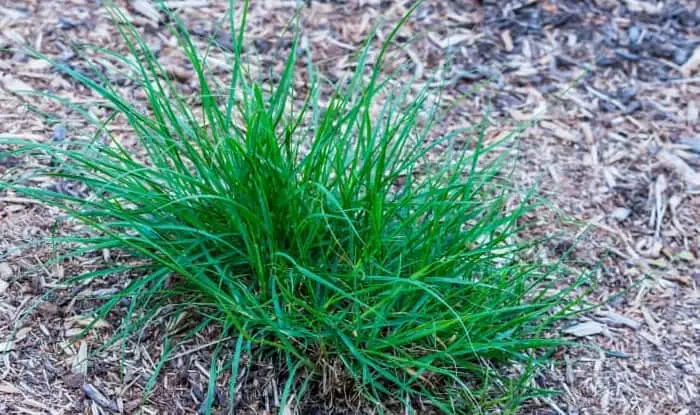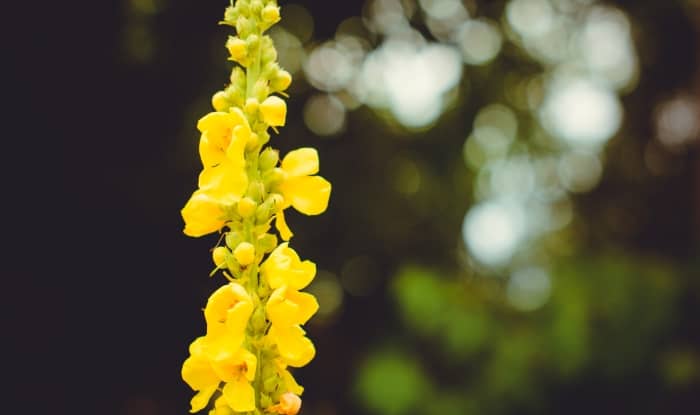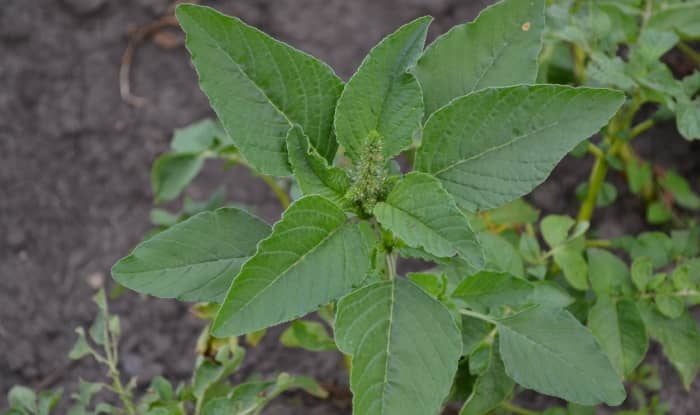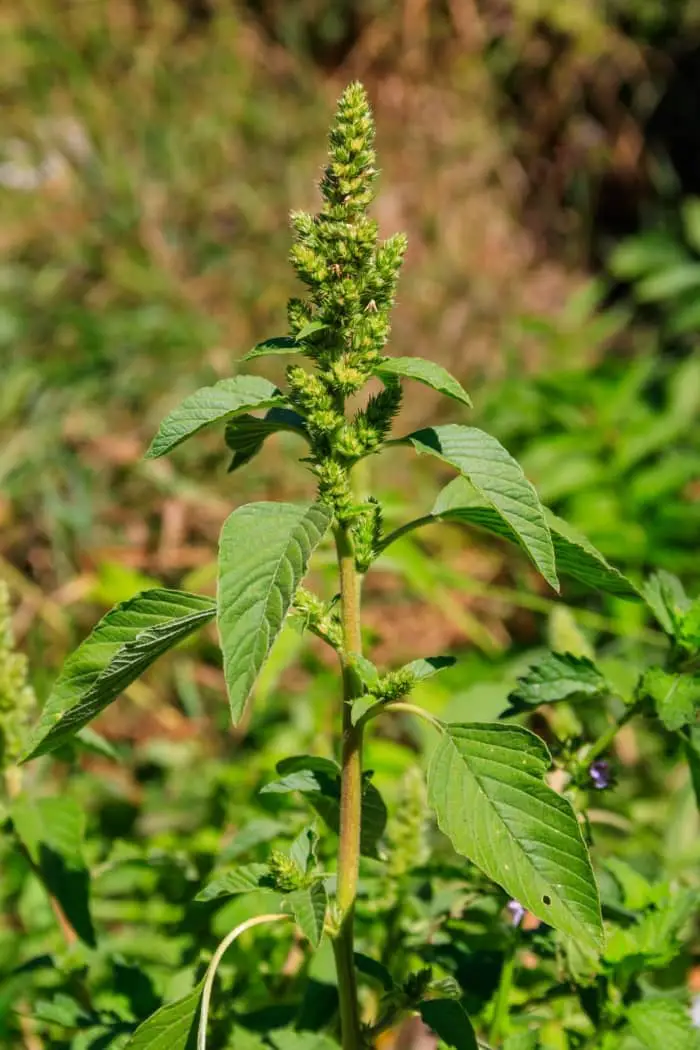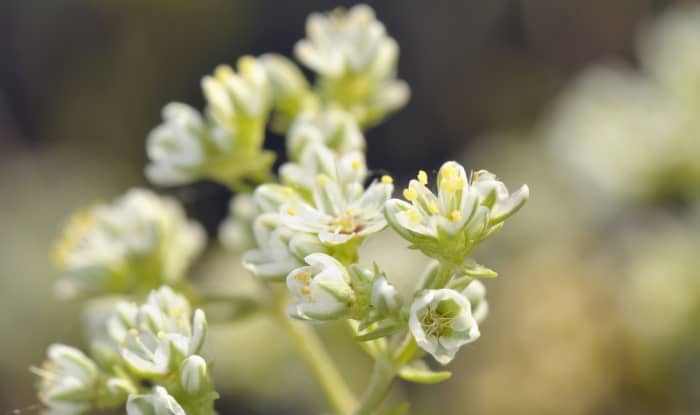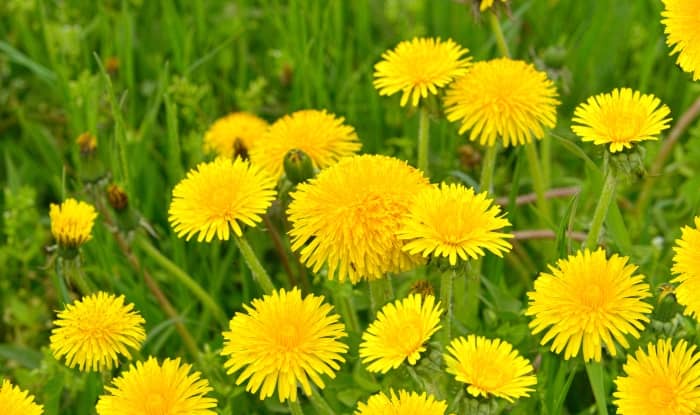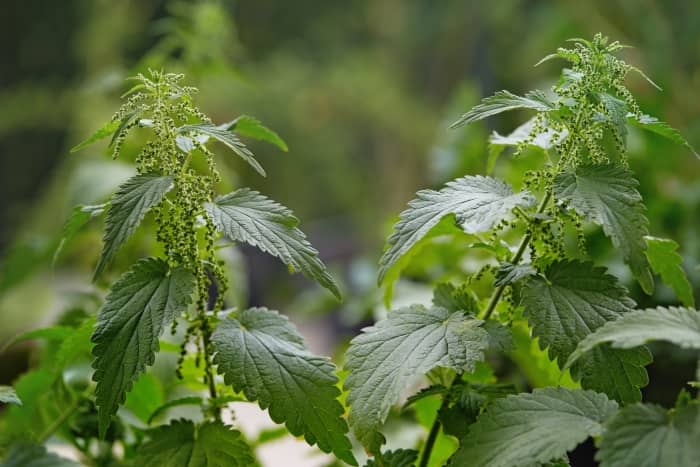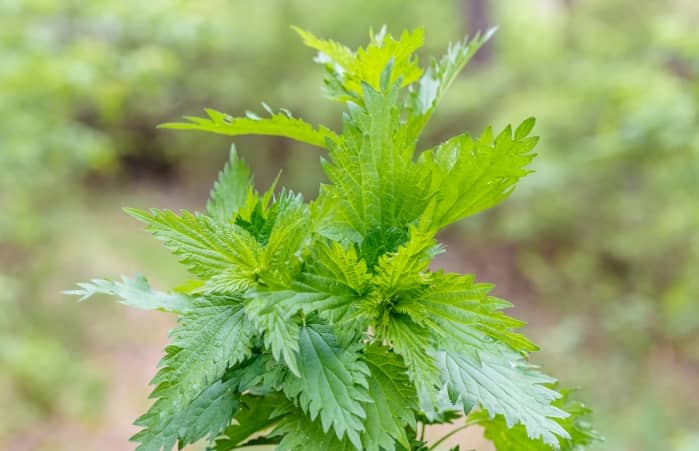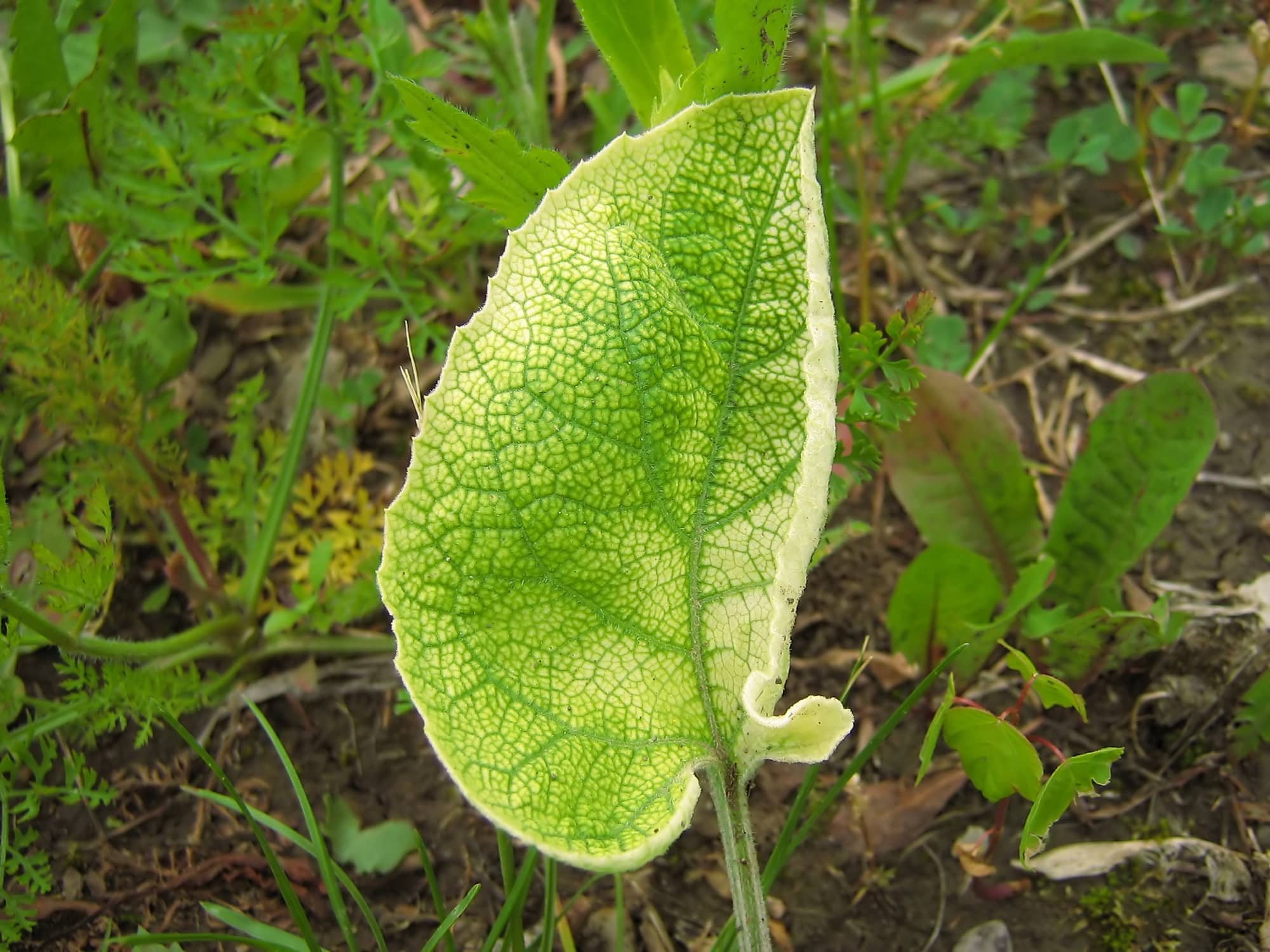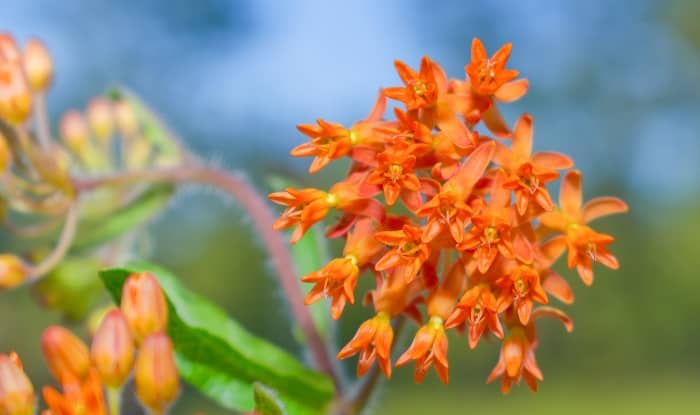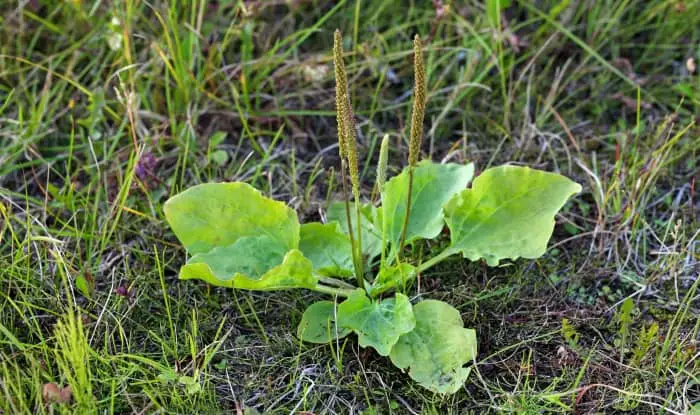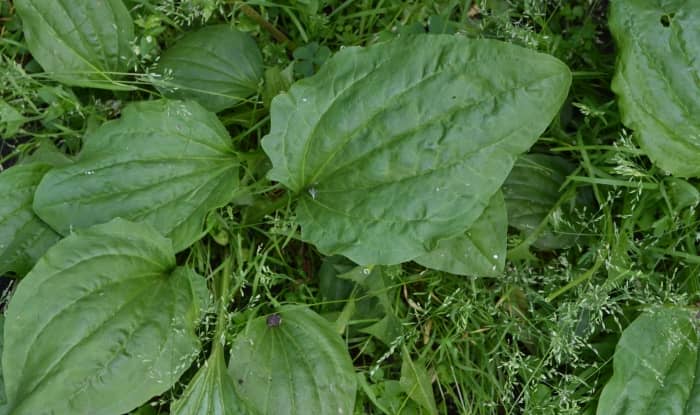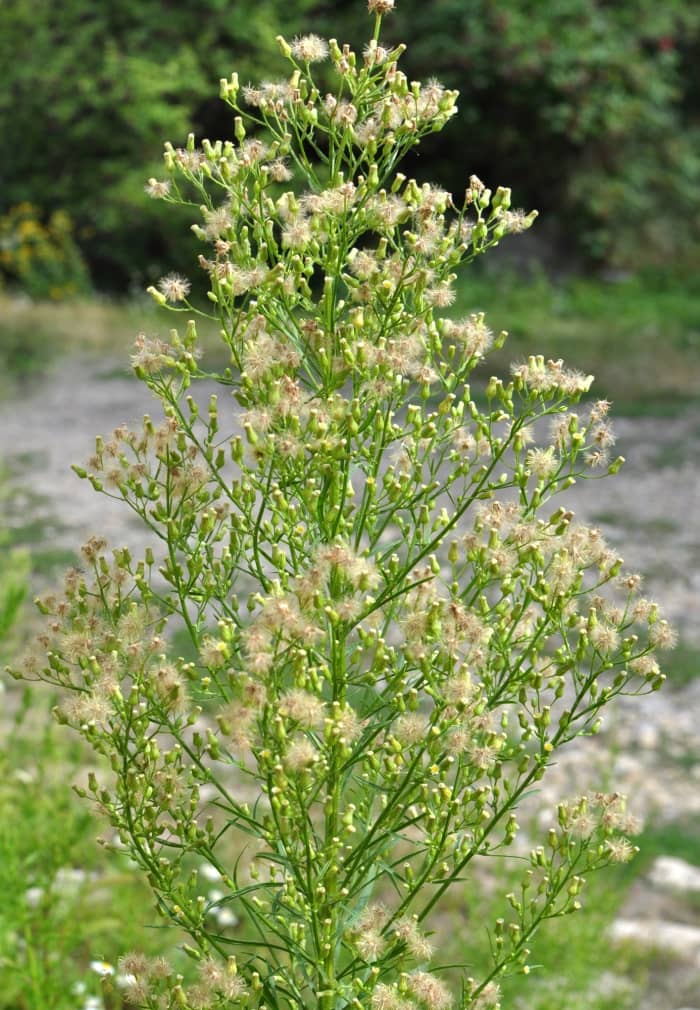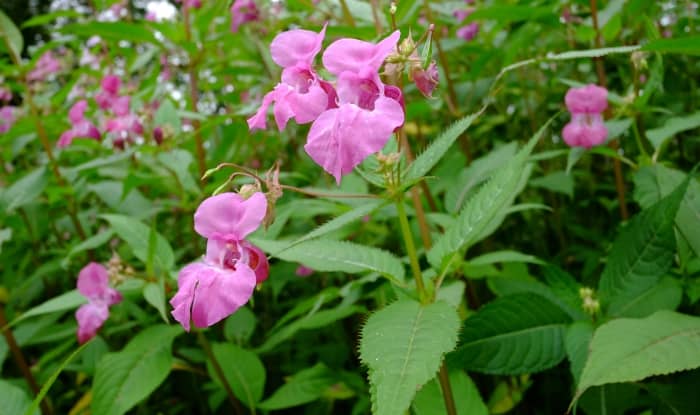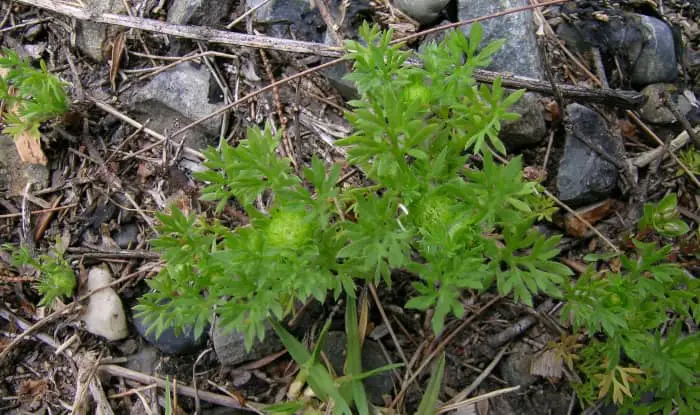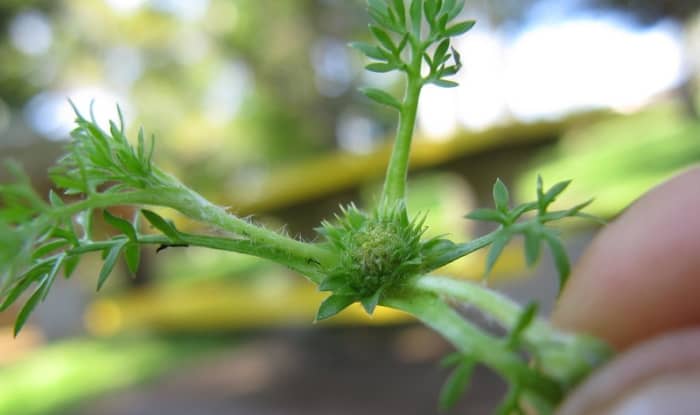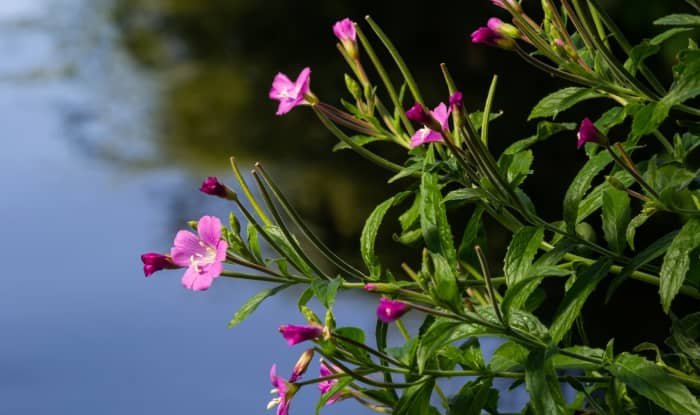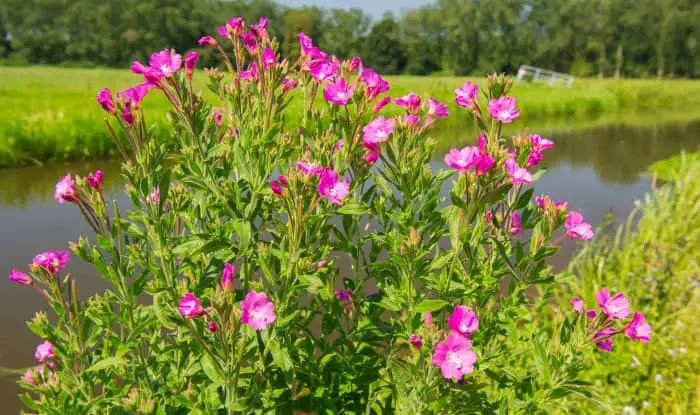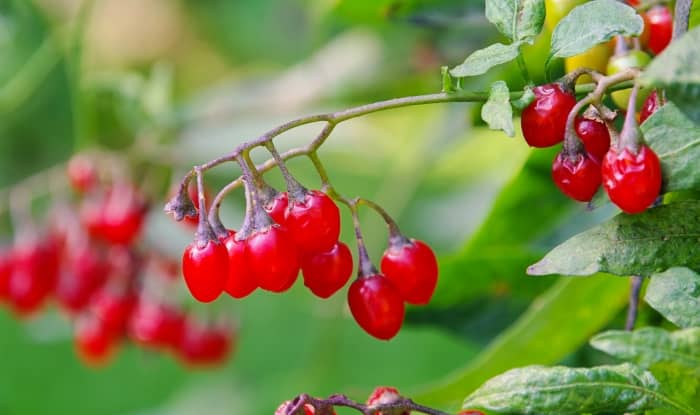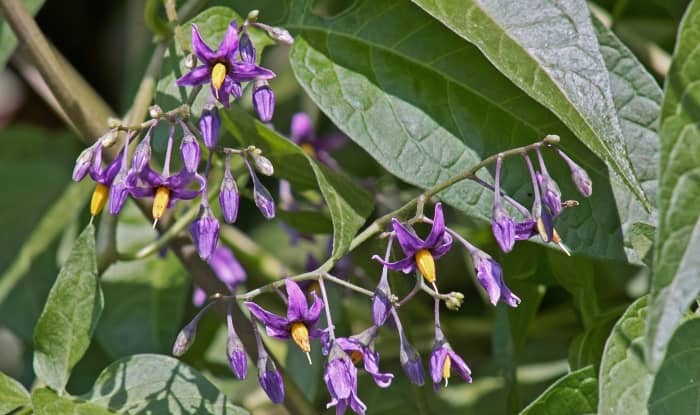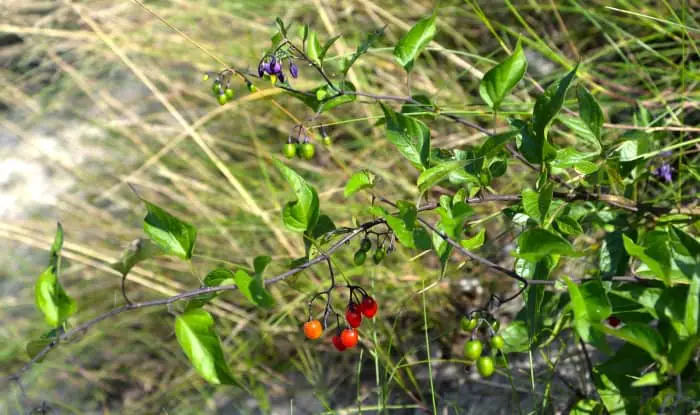Are you trying to identify some weeds in your yard?
In this list, we look at some of the most common types of weeds with seeds. I’ll help you to identify them using photos and detailed descriptions.
Let’s dive in.
Crabgrass (Digitaria sanguinalis)

Crabgrass is an invasive grassy weed. Only, unlike the rest of your lawn, its coarse texture, thick blades, and lateral growth cause it to stand out and look unsightly.
It’s a common annual weed that germinates, grows, and dies within the space of a year. But what it does during that year can have long-term consequences for your lawn.
Crabgrass plants produce up to 150,000 seeds (1). And when they die, these seeds are left behind ready to germinate in spring the following year. Leading to a weed infestation.
Like some other types of garden weeds, if you leave crabgrass to grow it will crowd out and smother your lawn grass as it takes over.
And mowing won’t help you get rid of the problem, as they can set seed even when they’re only ½ inch tall. Which is lower than the recommended height for mowing lawn grass.
In order to control crabgrass, the best method is to prevent the seeds from germinating. So it’s a good idea to use a pre-emergent herbicide in early spring.
Post-emergent herbicides kill the crabgrass that’s already growing. But if they’ve already set seed, the problem will return next year.
You can also pull the plants out by hand. But depending on the size of the problem, this can be a lot of work.
Common Mullein (Verbascum thapsus)
Also called great mullein and woolly mullein, common mullein is a giant weed that grows over 7 ft. tall. The common mullein plant has large grey-green leaves that are thick and oval-shaped. A fuzzy covering of woolly hairs gives the mullein leaves a velvety texture. The leaves grow from 4-12 inches long and 1-5 inches wide.
Common mullein is a biennial weed with seeds. In the first year, the plant grows a basal rosette of furry leaves. And in the second year, the weed develops a tall stem. Common mullein flowers from June to September. With small yellow flowers clustering in a large spike at the top of the stem.
Originally native to Europe, Asia, and North Africa, great mullein is an invasive weed in many areas of North America and Australia. It’s a common farm weed found growing among crops and in disused fields.
The weed is a prolific seeder. Each plant produces 200-300 seed pods with each seed pod containing up to 800 tiny brown seeds. This means that a common mullein plant can have up to 300,000 seeds (2). The seed capsules release the seeds to the ground, falling near the parent plant.
Redroot Pigweed (Amaranthus retroflexus)
Redroot pigweed is a summer annual broadleaf weed with seeds common in agricultural land and disturbed areas, such as ditch banks and roadsides. But you can also find redroot pigweed encroaching on gardens and landscaped areas. The weed usually grows up to 4 ft. tall, but with plenty of sunlight and little competition, it can grow much taller.
Redroot pigweed takes its name from its thick, red taproot. But the lower stems of the weed are also red. The upper plant stems are hairy with lance-shaped leaves growing from leaf stalks. Egg-shaped leaves grow from the lower plant stems. The leaves grow alternately along the stem, have prominent veins, and are often reddish underneath.
The weed blooms from early summer through to the first frost, producing clusters of inconspicuous green flowers densely packed along the branches and in spikes at the end of stems.
The weed sets seed in late summer/fall, with a single mature plant capable of producing 200,000 seeds. The seeds vary from dark red to black and are shiny.
Hairy Bittercress (Cardamine hirsuta)
Hairy bittercress is an annual weed with seeds that emerges in early spring, usually about February. You can identify this weed by its scalloped leaves arranged alternately around a central stem, and its little white flowers. The stem and leaves have small hairs that are most noticeable on young plants.
Hairy bittercress thrives in wet soil and it’s common to notice its growth after you’ve had a period of heavy rainfall.
It’s a good idea to eradicate hairy bittercress from your lawn before the small white flowers produce seedpods each containing up to 30 seeds.
The seed pods explode and propel the seeds up to 16 ft. from the plant (3). The seeds germinate in the fall and It doesn’t take many plants to create an infestation the following spring.
Hairy bittercress has compound leaves that consist of multiple small leaflets growing along a leaf stalk with a single leaflet at the tip. The leaves grow to about 6-inches long
The flowers have four white petals arranged in a cross that eventually fall off leaving behind a green seed pod.
Dandelions (Taraxacum spp.)
Dandelions are one of the most common lawn weeds with seeds.
There are more than 250 types of dandelions. And they all have a similar distinctive-looking flowerhead. Most dandelions have yellow flowers. But you can find dandelions with pink and white flowers as well.
Dandelions have long, narrow, leaves with jagged lobes that grow in a basal rosette. Sometimes the leaves are hairy and sometimes they’re smooth.
Most dandelions bloom in the spring. The flowerhead consists of numerous florets and grows at the end of a long stalk. When dandelions set seed, the flowerhead is replaced by a fluffy seedhead consisting of small seeds easily dispersed by the wind.
Stinging Nettle (Urtica dioica)
Stinging nettle is a herbaceous perennial weed that everyone has a brush with at some point. And that brush is often painful. Because stinging nettle has large, serrated-edged leaves with stinging hairs that cause a painful rash when touched.
Once you’ve had this unpleasant experience you quickly learn to recognize the sight of stinging nettle leaves. They’re dark green and grow up to 6-inches. Growing oppositely on a green, wiry stem. When the weed blooms in the summer it produces clusters of small greenish-white flowers.
Stinging nettles are an invasive weed. The female plant produces a large volume of seeds that grow in clusters from late summer to early winter, initially green but turning brown. The weed also spreads through rhizomes. It’s very difficult to eradicate once it becomes established in an area.
Despite being a weed that most people don’t want anything to do with, it also has some use. Stinging nettles are an edible weed. And you can eat the roots, leaves, stems, and seeds. Just remember to cook them first. It’s also a medicinal plant with many health benefits.
Common Burdock (Arctium minus)
Also known as lesser burdock, common burdock is a biannual weed. It’s a common weed to find growing in your backyard and on your lawn. You also find it in pastures, paddocks, next to roadsides, and alongside streams.
Identifying burdock is simple. During the first year of growth, the weed develops a basal rosette of large leaves that reach 6-18 inches long and 4-14 inches wide. The leaves are dark green, heart-shaped, and have fine hairs on the underside. The broad leaves have reddish stems that make them resemble rhubarb leaves.
In the second year of growth, burdock sends up a tall hollow stalk that can reach 6 feet high with alternate growing leaves that are smaller than the basal leaves. The plant blooms from July to October, producing lavender to purple flowers at the end of branches and in the leaf axils.
The flower heads resemble a thistle and are covered in spines. Each flower head dries up as they age and turn into prickly burrs with curved spines. The burrs easily hook onto clothing or the fur of animals to spread the seed they contain.
Once common burdock is established in your yard it’s difficult to get rid of the weed because of its deep taproot and the large volume of seeds each plant produces, around 15,000 on average. The plant only reproduces by seed, so try to prevent it from doing so by cutting.
Unlike many weeds with seeds, common burdock has some uses. The leaves, stalks, and roots are all edible, and you can use them for medicinal purposes.
Butterfly Weed (Asclepias tuberosa)
Butterfly weed is also known as orange milkweed and butterfly milkweed. As these names suggest, it’s a member of the milkweed family. The plant is native to North America. And gardeners sometimes choose to grow it as an attractive wildflower in home gardens. The plant has showy flowers that are well-known for attracting butterflies, bees, hummingbirds, and other pollinators during the blooming season.
Butterfly weed produces clusters of small yellow-orange to bright-orange blossoms. Each flower cluster measures about 2.5-inches across and grows at the top of straight, hairy stems. Occasionally, you might find this weed with orange-red flowers or yellow flowers.
Each plant has many stems. With dark-green, lance-shaped leaves growing alternately. After flowering, the weed develops large seed pods. By early autumn, the seed pods dry up and open, releasing many small brown seeds. Each seed has silky hairs attached that help the seed float in the air and fly with the breeze.
Nutsedge (Cyperus rotundus)

YELLOW NUTSEDGE WEED BY HOMER EDWARD PRICE, CC BY 2.0
Before it blooms, nutsedge resembles tall grass. But there are some distinctive differences when you look closely
To start with, nutsedges are V-shaped. And they’re usually thicker and stiffer. With leaves in a set of 3, rather than the set of 2 commonly seen on grass.
Yellow nutsedge produces golden-yellow flowers and yellow seeds. With purple nutsedge producing red-brown flowers when they bloom, and dark brown or black seeds.
It’s a perennial weed that spreads by seed, underground rhizomes, bulbs, and tubers. With each tuber having the capacity to create hundreds of shoots in a 3-6 ft. area. As well as forming 100+ new tubers.
This makes nutsedge one of the worst weeds to control. The key is to stop nutsedge from establishing itself, as once it does, it’s difficult to get rid of.
Make sure you remove young plants before they’ve had a chance to develop the tubers.
If you find mature nutsedge plants already established in your garden, then pulling them out is unlikely to work. If you leave the rhizomes and tubers behind they will continue to sprout.
Instead, get a herbicide that targets nutsedge and can kill everything above and below the ground.
A more organic strategy is to grow a dense lawn that can crowd it out. Preventing it from being able to successfully root.
Nutsedge often thrives in waterlogged soil. So eliminating the wet conditions that help it to grow is a good idea.
Broadleaf Plantain (Plantago major)
Broadleaf plantain is also called white man’s foot – a name given to it by Native Americans who associated the plant with the settlers.
It’s a perennial broadleaf weed often seen around farmland and other areas of disturbed soil and a common garden weed.
You can recognize broadleaf plantain by its big leaves that grow in a rosette. Flower stems grow vertically from the center of the weed and feature clusters of tiny greenish-brown flowers at their tips that bloom from June to September. The leaves are oval-shaped, smooth, and grow up to 20 cm long.
You can eat the highly nutritious leaves of broadleaf plantain. But think carefully before allowing this weed to grow in your garden. Each plant produces up to 20,000 seeds. And they can survive in the soil for a long time. So even after you get rid of the plant, plantain will keep appearing in your yard for many years.
Horseweed (Erigeron canadensis)
Also called mare’s tail, horseweed is a summer annual that’s a common landscape and agricultural weed. It’s a tall weed with hairy leaves that develops a single hairy stem that can reach 6-10 ft. in height.
The long, narrow leaves grow alternately from the stem without a petiole and are irregularly toothed.
The stem branches at the very top of the weed and produces small, white daisy-like flowers when in bloom. The flowers give way to tiny seedheads from late July to October, similar to those found on dandelions, that are dispersed by the wind. Each plant can produce up to 200,000 seeds.
Himalayan Balsam (Impatiens glandulifera)
Himalayan balsam is an annual herb that’s also known as copper tops, policeman’s helmet, gnome’s hatstand, Indian Jewelweed, and touch-me-not.
As the name suggests, it’s native to the Himalayan mountain range. And more precisely, to the area between Uttarakhand and Kashmir.
It was introduced in the 19th century to Europe and North America as an ornamental plant. But it’s now often considered an invasive plant.
It grows in a range of soil types. But you’re most likely to find it along the banks of rivers and streams. You can also come across it in wetlands, forests, and roadsides. Sometimes, you might even find it growing in your lawn grass.
Himalayan balsam grows up to 6-7 ft. tall. The red-purple stems are smooth and hollow. And they thicken as the plant grows to maturity. There are 5-10 pink or white flowers on each stem, with each flower having 5 petals. Each leaf is large, oval, and pointed at the tip.
The ripe seed capsules are fragile and explode when touched, spreading seeds meters from the parent plant. This has earned Himalayan balsam the alternative name of touch-me-not. The weed has sticky seeds that attach to shoes, clothing, and car tires for transportation to new locations.
This weed with seeds spreads quickly in areas it infests. Densely covering an area and crowding out the indigenous vegetation. This reduces biodiversity in the area.
Lawn Burweed (Soliva sessilis)
Lawn burweed is also known as spurweed, bindi weed, and stinging grass. And that final name is a good description of what it feels like to walk on a burweed-infested lawn with bare feet.
Lawn burweed is an annual broadleaf weed that grows during the cool-season. The seeds germinate in the fall. And by the spring, the weed disperses small spiky balls in the grass containing the seeds — the stickers. The prickly seeds easily stick to clothing and fur.
SOLIVA SESSILIS FRUIT BY HARRY ROSE
Lawn burweed thrives on thin turf and grows in small patches to a height of 3-4 inches. It produces small, feathery leaves that look like parsley and grow to about 1-½ inches long. In spring, lawn burweed produces tiny flowers that are difficult to see without close inspection.
Hairy Willowherb (Epilobium hirsutum)
Hairy willowherb is an attractive pant that’s sometimes grown as an ornamental. But when it escapes cultivation it can spread aggressively and can be difficult to get rid of. It’s now considered an invasive and noxious weed in some states.
Hairy willowherb grows to around 6 ft. tall with erect branched stems and lance-shaped, toothed leaves that grow opposite each other clasped to the stem. The stems and leaves are covered with soft hairs.
From July to August the plant blooms, producing pink purple-flowers with notched edges and white centers.
The weed spreads through seeds that develop in narrow long seedpods. The weed seeds have long white hairs and float on the wind to new locations. The plant also spreads through thick rhizomes.
Hairy willowherb is often found in wetlands in the same areas as purple loosestrife and grows in dense stands that crowd out native plants.
Bittersweet Nightshade (Solanum dulcamara)
The bittersweet nightshade plant is also known as blue bindweed, bitter nightshade, poison berry, and climbing nightshade. Bittersweet nightshade is a perennial woody vine that grows up to 10 ft. in length and climbs when there’s adequate support.
All plant parts are toxic, and the noxious weed produces clusters of poisonous bright red berries in the fall. Ovate leaves grow alternately on the stiff stems. The leaves are dark green and sometimes purple-tinged and reach between 2-4 inches long.
From May to September, the plant produces small bright purple flowers with eye-catching yellow anthers that hang in clusters.
Bittersweet nightshade spreads by seeds and can grow from stem and root fragments. The weed produces yellow seeds that appear flattened (4).
You’ll often find this weed growing around field edges, gardens, parks, roadsides, and wetlands as the plant likes moist soil.
Bittersweet nightshade is toxic. Although not the same plant as deadly nightshade or as dangerous, it can cause sickness in animals and children that eat its berries, sometimes fatal.
FAQ
Do garden weeds have seeds?
There are many types of garden weeds that have seeds. Some weeds produce hundreds of thousands of seeds that can sometimes lay dormant in the soil for decades, remaining viable, and sprouting when conditions are right. It’s important to deal with prolific seeders quickly before they set seed or you could be battling a weed infestation every year.
What are the weeds that shoot seeds?
Some of the common types of weeds that shoot seeds include hairy bittercress and Himalayan balsam. These weeds have seedpods that explode and eject the seeds far away from the plant helping the weed to spread.
References:
- Biology And Management Of Crabgrass – https://ag.umass.edu/turf/fact-sheets/biology-management-of-crabgrass
- Common Mullein, Verbascum Thapsus – https://hort.extension.wisc.edu/articles/common-mullein-verbascum-thapsus/
- Hairy Bittercress – A Winter Annual Weed to Watch – https://extension.psu.edu/hairy-bittercress-a-winter-annual-weed-to-watch
- Weed Watcher Guide to Invasive Plants – https://your.kingcounty.gov/dnrp/library/water-and-land/weeds/brochures/Weed-Watcher-Guide-to-Invasive-Plants-Web.pdf

